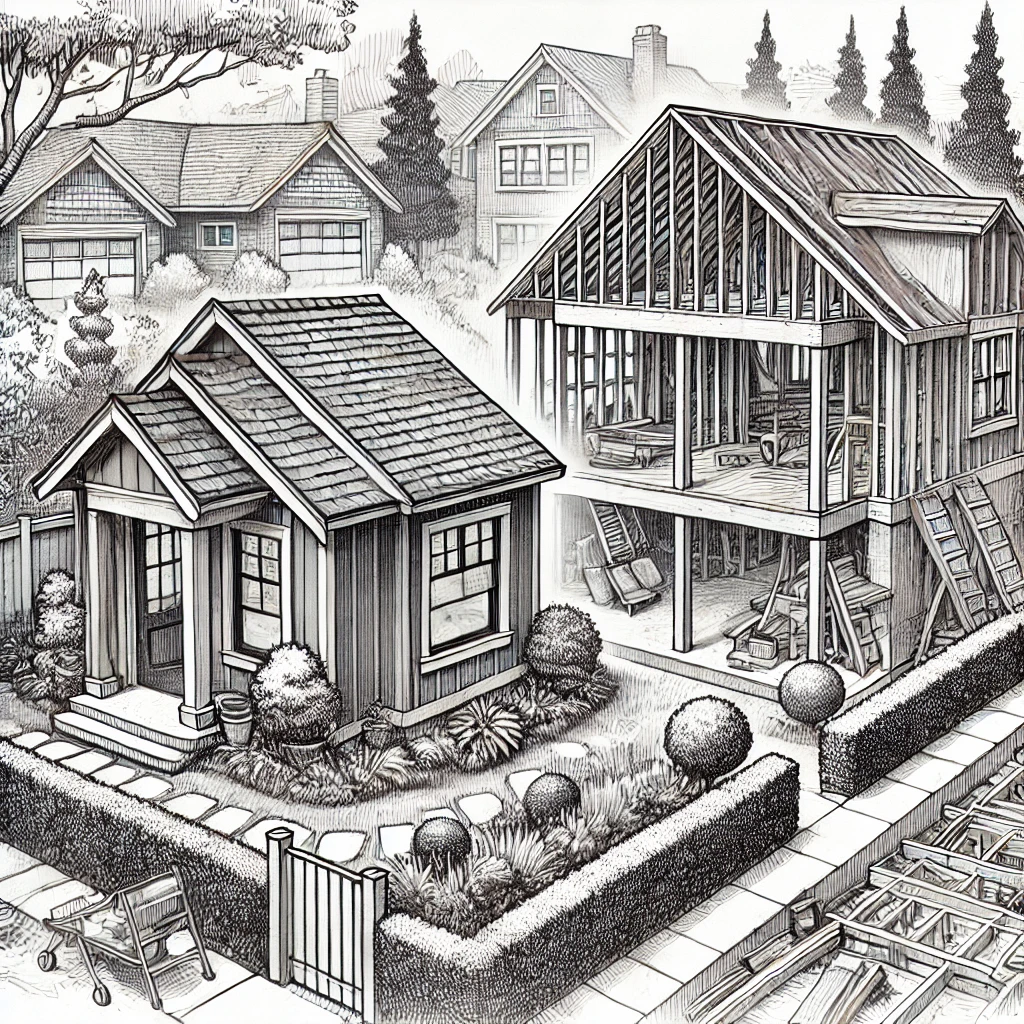Accessory Dwelling Units (ADUs) and home additions are popular methods for expanding living space.
While both increase property value and provide additional living areas, they serve different purposes and involve distinct construction processes.
This article explores the key differences between ADUs and home additions, providing homeowners with insights to make informed decisions.
What is an ADU?
An Accessory Dwelling Unit (ADU) is a secondary housing unit on the same property as a primary residence; they can be detached or attached to the main house and typically include full living facilities.
ADUs are usually anywhere from 600 to 1,200 square feet, with smaller variations available and known as JADUs (Junior ADUs).
ADUs require their own utility connections and must meet residential living standards.
What is a Home Addition?
A home addition involves expanding the existing structure of the main residence to create more living space.
Additions can vary in size and function, from extra bedrooms and bathrooms to expanded kitchens and living areas.
The major difference here is that additions are not usually created with the goal of providing a separate living unit and instead are often used to enhance a property. As such, they connect to the existing structure and use the same utilities.
5 Key Differences Between ADUs and Home Additions
Let’s take an in-depth look at the differences between ADUs and home additions to see how they compare.
1. Purpose and Use
The major difference to explore is the purpose/use of an ADU vs a home addition:
- ADUs: Serve as independent living units suitable for rental income, guest accommodations, or housing family members. They offer complete living facilities, providing a self-contained living space.
- Home Additions: Enhance the living space of the existing home. They are typically used to add specific rooms or expand existing areas, improving the overall functionality of the home.
ADUs are much larger projects that provide contained living spaces, whereas home additions simply add to existing living spaces.
2. Independence and Privacy
Another key difference that stems from the purpose of these structures is the privacy they offer:
- ADUs: Provide a separate living space with its own entrance, ensuring privacy for occupants. This makes them ideal for long-term rentals or independent living arrangements.
- Home Additions: These are fully integrated into the main house, sharing common areas and utilities. They are less suited for providing complete independence and privacy.
This one should be fairly obvious now we know what an ADU and addition actually are.
3. Construction and Cost
Most people would assume that an ADU would cost more than a home addition, and while this is true for a lot of cases, the maximum price can actually be quite similar for both:
- ADUs: Construction costs for ADUs can be higher due to the need for separate utility connections and compliance with residential building codes. The average cost to build an ADU ranges from $20,000 to $150,000.
- Home Additions: Typically cost less than ADUs as they utilize existing infrastructure. The cost varies depending on the addition’s size and complexity but generally ranges from $5,000 to $150,000.
It’s surprising how expensive some house additions can be, but in most cases, the average ADU will cost more than a standard house addition simply due to the size difference.
4. Regulatory and Zoning Considerations
ADUs and home additions face different challenges in terms of regulations and zoning, mostly on the side of the ADU.
- ADUs: Must comply with local zoning laws and building codes. This includes obtaining permits and adhering to regulations regarding size, occupancy, and utility connections. Some cities have streamlined ADU regulations to promote their development, like the City of Portland, for example.
- Home Additions: Also require permits and must comply with building codes. However, the regulatory process is typically more straightforward as additions are part of the existing structure.
If you’re looking for a more straight forward option, then a home addition could be the best choice.
5. Impact on Property Value
ADUs have a more significant impact on property value when compared to home additions:
- ADUs: Can significantly increase property value (up to 35% in some cases) due to their potential as rental units and independent living spaces. They offer flexibility and additional income potential for homeowners.
- Home Additions: Enhance the value of the home by increasing living space and improving functionality. The impact on property value depends on the type of addition and its integration with the existing structure, but the ROI can be very high.
ADUs definitely win on increasing property value, but they do cost more on average and are more difficult to get approved and built.
6. Financing Options For ADUs and Additions
The last difference is the available finance options for these types of constructions.
ADUs
Homeowners can use home equity to finance ADU construction, which typically offers a lower interest rate than a loan.
Some local governments provide grants and incentives for ADU builds as well, so it’s alway worth checking with your local authority.
Home Additions
Home Equity Lines of Credit (HELOCs) are often used to fund home additions.
HELOCs work by borrowing against available equity in your home, using it as collateral to provide a line of credit.
Outside of that, personal loans can be used, as well as personal savings if the home addition is relatively small.
Conclusion
ADUs and home additions both offer valuable solutions for expanding living space and increasing property value.
ADUs provide independent, self-contained living units suitable for rentals and guest accommodations, while home additions enhance the functionality and space of the existing home.
Understanding the differences in purpose, cost, and regulations helps homeowners make informed decisions that best meet their needs and goals.
